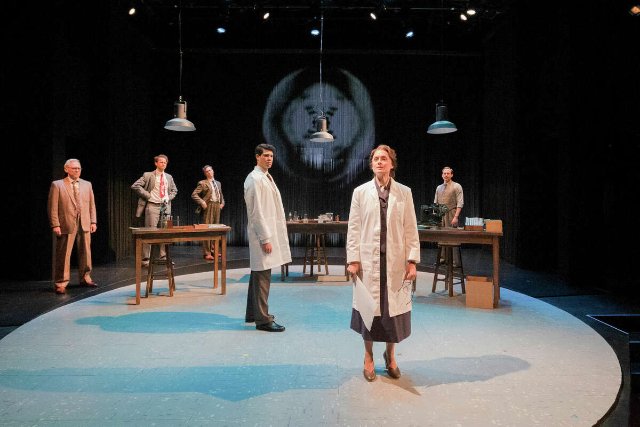Photo 51 by Anna Ziegler
Unwinding the Double Helix at Berkshire Theatre Group
By: Charles Giuliano - Jun 21, 2023
Photo 51
By Anna Ziegler
Directed by David Auburn
Scenic Design by Bill Clarke
Costumes by Elivia Bovenzi Blitz
Lighting by Daniel J. Kotlowitz
Sound by Scott Killian
Projections by Daniel J. Kotlowitz
Unicorn Stage
Larry Vaber Stage
Berkshire Theatre Group
Through July 1
Cast: Maurice Wilkins (David Adkins), Dan Casper (Shaun Anthony), Rosalind Franklin (Rebecca Brooksher), Francis Crick (Christian Coulson), Ray Gosling (Brandon Dial), James Watson (Allen Tedder)
The taut, austere, information crammed, one act play “Photo 51” rights a wrong. It dramatizes the true life story of the unaccredited role played by Rosalind Franklin (Rebecca Brooksher) in the discovery of the double helix pattern in DNA.
As the tightly crafted, absorbing drama reveals her research was inappropriately divulged by a “partner,” Maurice Wilkins (David Adkins), to colleagues Francis Crick (Christian Coulson), and James Watson (Allen Tedder).
They won the Nobel Prize in 1962 for constructing the double helix. Wilkins was included in the prize while Franklin, by then deceased, was not.
Drawing on the experimental results of others (they conducted no DNA experiments of their own), taking advantage of their complementary scientific backgrounds in physics and X-ray crystallography (Crick) and viral and bacterial genetics (Watson), and relying on their brilliant intuition, persistence, and luck, the two showed that DNA had a structure sufficiently complex and yet elegantly simple enough to be the master molecule of life. Wilkins and Franklin had obtained high-resolution X-ray images of DNA fibers that suggested a helical, corkscrew-like shape.
Controversy entails Watson and Crick’s use of Franklin's crystallographic evidence of the structure of DNA, which was shown to them, without her knowledge, by her estranged colleague, Wilkins, and by Max Perutz. Her evidence demonstrated that the two sugar-phosphate backbones lay on the outside of the molecule, confirmed Watson and Crick's conjecture that the backbones formed a double helix, and revealed to Crick that they were antiparallel. Franklin's superb experimental work thus proved crucial in Watson and Crick's discovery. Yet, they gave her scant acknowledgment.
There is a lot of science to unpack which might well be plodding exposition here skillfully unraveled in the fast clip of direction by the ever meticulous and masterful David Auburn.
The exact science of this remarkable discovery, indeed the genetic structure of life itself, is far more complex. In Ziegler’s Cliff Notes reduction the drift is that Franklin was cheated and dissed by smarmy, sexist, Anti-Semitic colleagues. In real life Watson proved to be even more racist, vile and unhinged. We get no hint of his subsequent dark side in this play.
Like its double helix the DNA of Ziegler’s play unwinds gradually and artfully.
The action is framed in the period of the immediate post war. Franklin has completed her dissertation in France and is invited to run a lab at London’s King’s College.
In the stark design by Bill Clarke she steps into an egg shaped oval with a low, slowly inclined wall. Wearing a sensible suit and low, plain heels, designed by Elivia Bovenzi Blitz, she descends into the space.
She is welcomed by Wilkins who greets her as his new assistant. Insisting on being addressed as Dr. Franklin they haggle through an agreement to be “partners.” She is assigned an assistant, Ray Gosling (Brandon Dial), who obeys her but also functions as a go between.
After she is provided with the necessary equipment there is an immediate issue of solving a problem with the camera. With no time or patience for human interactions she is entirely focused on her work. Soon there are spectacular results but she refuses to speculate and theorize. Franklin is only motivated to find physical evidence.
That conceptual leap will be broached by Watson and Crick when, without her authorization, they have access to the seminal Photo 51. The implication is that, given more time which she didn’t have, she would have solved the puzzle.
While on a “date” with a colleague, Dan Caspar (Shaun Anthony), she doubles over in pain. It is revealed that she has tumors on her ovaries which she dubs “Watson and Crick.”
The drama has important reveals about the role of women in science and lingering Anti Semitism. We learn that women were excluded from Harvard’s physics labs.
What saves this experience from devolving into Bio Sci 101 are the fine tuned performances of Brooksher and Adkins. In an odd post-script, the evening ends with a posthumous interaction. There is a groping whiff of affection and a sense of what might have been.
It’s a forced attempt to turn the tale of stalwart scientific research into a love story.

